Technical Guidelines for Integrated Disease Surveillance ... - PHRplus
Technical Guidelines for Integrated Disease Surveillance ... - PHRplus
Technical Guidelines for Integrated Disease Surveillance ... - PHRplus
You also want an ePaper? Increase the reach of your titles
YUMPU automatically turns print PDFs into web optimized ePapers that Google loves.
Public health action Conduct active case finding <strong>for</strong> specific target groups. Conduct primary prevention activities such as promotion of safer sex behaviours, socialmarketing and provision of condoms. Assess use of algorithms <strong>for</strong> detection and treatment of STIs, and improve healthworker practice with algorithms. Include STI prevention and care services in maternal and child health, and familyplanning services. Target acceptable and effective STI prevention and care services to populationsidentified as vulnerable to STI transmission.Promote early STI health seeking behaviour.Analyse and interpretdataTime:Place:Graph cases each quarter.No recommendation <strong>for</strong> analysis of place.ReferencePerson:Count quarterly cases and analyse cases by age, occupation and maritalstatus.<strong>Guidelines</strong> <strong>for</strong> Sexually Transmitted Infections <strong>Surveillance</strong>. Geneva. UNAIDS and WorldHealth Organization. WHO/CDS/CSR/EDC/99.3. UNAIDS/99.33ETrachomaBackground Trachoma is an infectious eye disease, which causes inflammation and scarring of theconjunctiva, the inner lining of the eyelid, thus leading to blindness. It is caused by microorganism, Chlamydia trachomatis, which gives rise to theinflammation of the conjunctiva covering the inside of the eyelids. Environmental factors such as shortage of potable water, and poor personal andenvironmental hygiene practises are the main risk factors. It is the second largest cause of blindness in the world after cataract. It is a very common disease, particularly in developing countries. There are at least 150million people in the world suffering from active disease, 6 million of whom have goneblind due to the disease. In Ghana, the disease is a public health problem especially in Northern and Upper-West regions of the country. After several years of disease, this inflammatory may cause scarring of the eyelid, laterleading to inturned eyelashes that rub on the cornea. Subsequent loss of vision occursbecause of scarring of the normally transparent cornea. Scarring is common in olderchildren but the serious complication of inturned eyelashes and cornea scarring do notusually appear be<strong>for</strong>e the adult age. Thus the blindness due to trachoma is mostcommon in adults.<strong>Surveillance</strong> goal Early detection and prompt treatment of cases with the goal of reducing the occurrenceof blindness among affected individuals. Conduct specific prevalence surveys in endemic communities and carry out appropriatetreatment.Case definition The case definition is based on classification of the disease. There are two <strong>for</strong>ms ofclassification.The presence or absence of ongoing trachomatous inflammation “Active” trachoma: This implies the presence of ongoing trachomatousinflammation corresponding to TF with or without TI. “Cicatricial”, “healed” or “inactive” trachoma: Signs of trachomatousinflammation are not visible, but scarring (TS with or without TT) is present.The stage of development of the disease TF = Presence of trachomatous inflammation, indicating current infection. TI = Presence of intense trachomatous inflammation, indicating severe currentinfection with increased risk of scarring.108<strong>Technical</strong> <strong>Guidelines</strong> <strong>for</strong> <strong>Integrated</strong> <strong>Disease</strong> <strong>Surveillance</strong> and Response in Ghana















